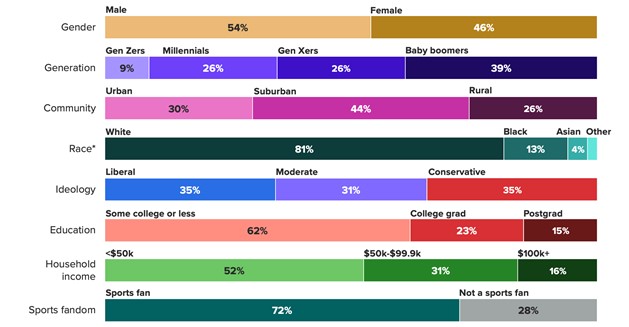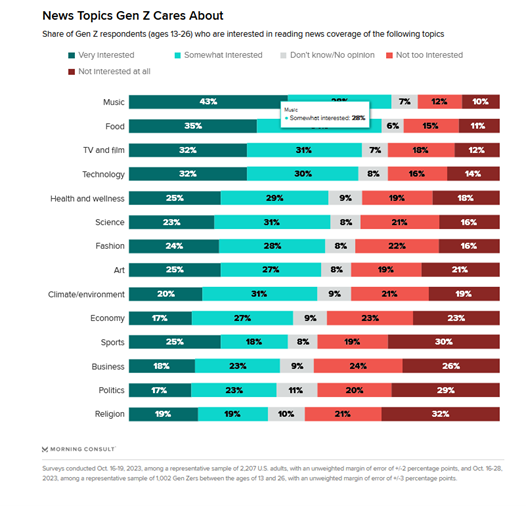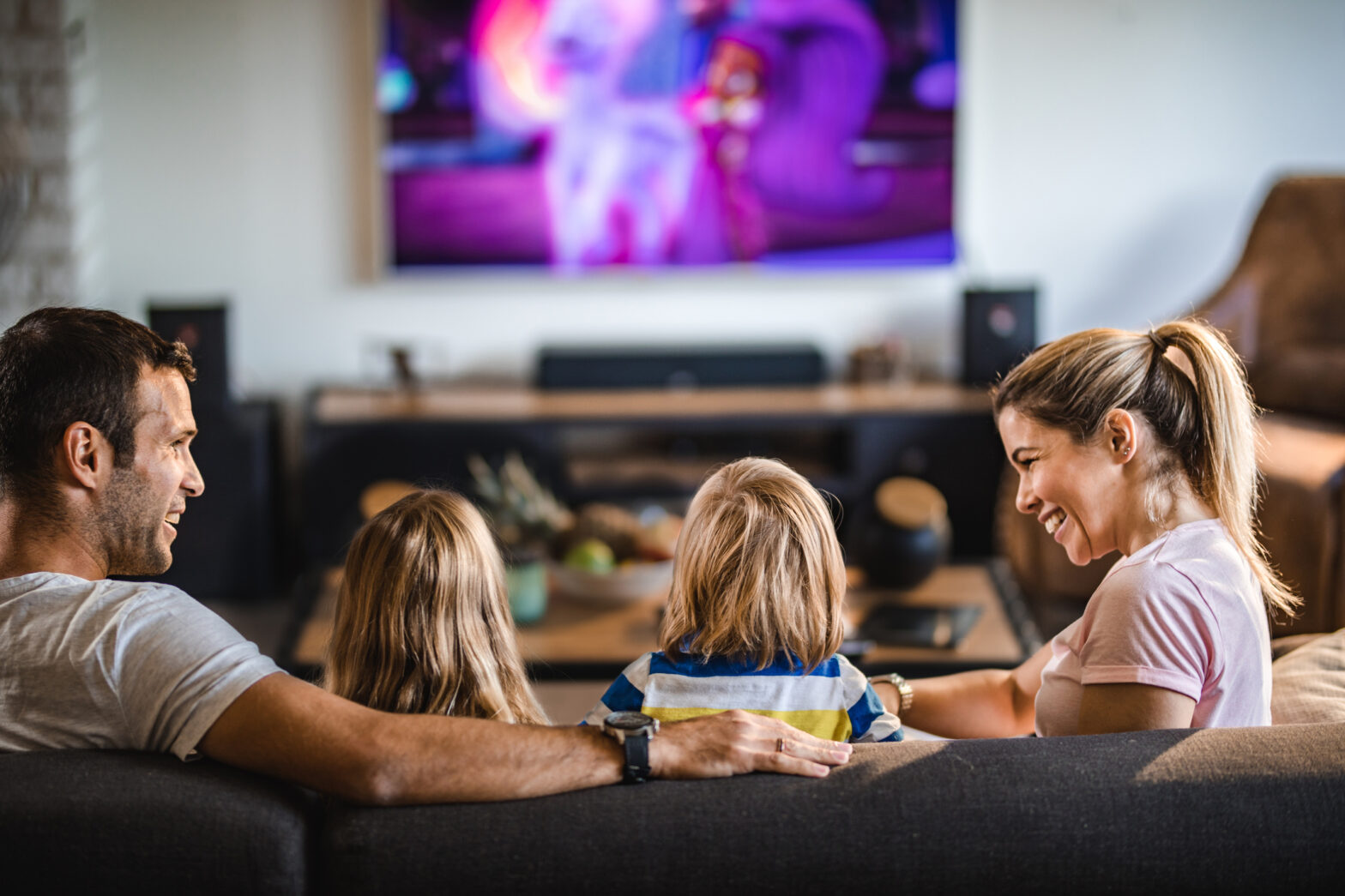Data from Morning Consult Pro shows that although the audience for traditional TV is made up more of Generation Xers and Baby Boomers, younger audiences cannot be ignored.
Millennials and Generation Z Also Watch TV
When imagining the audience for linear TV, many advertisers think of older people who are not very tech-savvy or show little interest in other entertainment experiences such as watching films or playing video games. But this is not true. According to the survey, 65% of the daily viewers of traditional TV are indeed Generation Xers or Baby Boomers, however, the data shows that a significant proportion of younger viewers are also paying attention to linear TV. It’s just that the situations or needs they have when sitting in front of the TV screen may be slightly different for each target group.
People watch television and other forms of video for a variety of reasons - from the need to unwind to the desire for solace or simple distraction. Unlike some forms of video, television is essential for almost all of these needs. There is something for everyone - including younger viewers for whom watching TV (for example, trendy reality shows) is often also an important element in communication - often a shared experience and subsequently a topic of conversation.
For example, 35% of those who said they watched traditional TV daily in February 2023 were Generation Z adults or millennials.
 Source: pro.morningconsult.com
Source: pro.morningconsult.comAlthough linear television is a medium with a longer history, it still has an incredible reach. Traditional television appeals to a portion of Generation Z and millennials, despite younger adults increasingly seeking digital entertainment.
In addition, members of Generation Z and millennials are more likely to subscribe to streaming services than their older counterparts.
How to impress? TV advertising for young people must have the right content
The younger audience has its specifics. These include the acceptable length of TV programmes and the type of content. Brands that can capture these specifics and position their TV spots correctly based on them can achieve significantly higher effectiveness with the younger generation:
- Younger viewers prefer shorter shows: members of Generation Z are used to consuming and changing content quickly. The ideal length of TV and film programmes is therefore shorter for them than for the general population. While 52% of Americans say the ideal length of a TV episode is an hour or more, only 25% of Gen Zers feel the same way. More than one-third of Gen Zers said that the ideal length of a TV episode is either 30 minutes (34%) or 45 minutes (35%). In the general population, only a quarter (21%) of all American adults hold this view.
- Choosing the right content is also important: Generation Z is not particularly interested in politics or economics; its focus is on lifestyle and entertainment. However, some content categories will become more important to Gen Zers as they get older. For example, 45% of Gen Z youth said they are interested in health and wellness. For older Gen Z individuals, this figure is 60%. However, some areas are unlikely to be attractive for this generation even later. In particular, business and politics were at the tail end of the list of news areas tested.
 Source: pro.morningconsult.com
Source: pro.morningconsult.comAs in all other areas, the key here is the ability of brands to use these specifics to their advantage. Who can you take inspiration from? Take a look at the brands that Generation Z counts among its favourites. The list includes Nike, Adidas, Fenty Beuauty, Doritos, Apple, Google, and Amazon. Representatives of brands that are present in the Czech environment include Alza, Kofola, or Lidl.
Can you figure out why their campaigns still appeal to the younger generation?
Video: Lidl - Hlas Lid(l)u 2023 (Voice of Lidl/people)
 Kofola
KofolaGeneration Z, more than any other generation, seeks out brands that not only match their personal values but also support them through their actions and reflect their demand for interaction and entertainment, authentic content, sustainability, as well as diversity and inclusion and other factors that resonate with this generation and with which they can identify.
Czechs Love TV
According to fresh data from the ATO’s Continuous Survey, watching TV remains one of the most popular activities among Czech households. In addition, television is also watched via the Internet on so-called second screens, i.e. on personal computers, smart mobile phones and tablets, which is close to the younger generation. Samba TV’s research shows that Generation Z frequently watches TV while shopping online, creating an opportunity for advertisers to drive immediate results across all screens. In addition, entertainment platforms and social media apps are the main ways for these consumers to discover new shows and films, with TikTok being the most common channel this demographic turns to.
The key understanding is that Generation Z uses TV differently than any other generation. Samba TV co-founder and CEO Ashwin Navin elaborates, “This generation is changing the way content is consumed across all screens, which points to the critical need for advertisers to adopt an all-screen approach that connects all the dots where these viewers watch TV today.”
Even Older Audiences Have the Potential to Develop
The requirement to think about the needs of different audience groups is not only applicable to the younger generations. Therefore, the fact that traditional television is preferred by Generation Xers and Baby Boomers can also be seen as a great opportunity.
According to OMG Research’s survey on the so-called silver generation, the standard of living of the Czech generation aged 55-69 is improving and those who have already reached retirement age want to spend it more actively than the previous generation of senior citizens. They are staying economically active longer and, due to the COVID pandemic, they are no longer afraid of online shopping. The media behaviour of people aged 55-69 is significantly influenced by traditional media. Compared to the 15-54 age group, they watch more TV, print media, radio and news websites. Of the TV viewing, linear TV is still the dominant channel (two thirds of them watch it). Most of them are satisfied with the basic offer and do not need to buy VOD services.
Media giants seeking to increase the reach of streaming services should use traditional platforms to bring key streaming shows to Gen Xers and Baby Boomers that older viewers would otherwise be unaware of due to their devotion to linear television.
At the same time, it is good to keep in mind that television still has one fundamental characteristic as to why people of all generations watch it. Regardless of whether it is online or linear, it has the power to bring people together.
The Next Myth? Social Networks!
Next time, we will look at the benefits of TV advertising cooperating with other media channels and explore in more detail the myth that brands nowadays only need to advertise on social media.
Sources: pro.morningconsult.com

